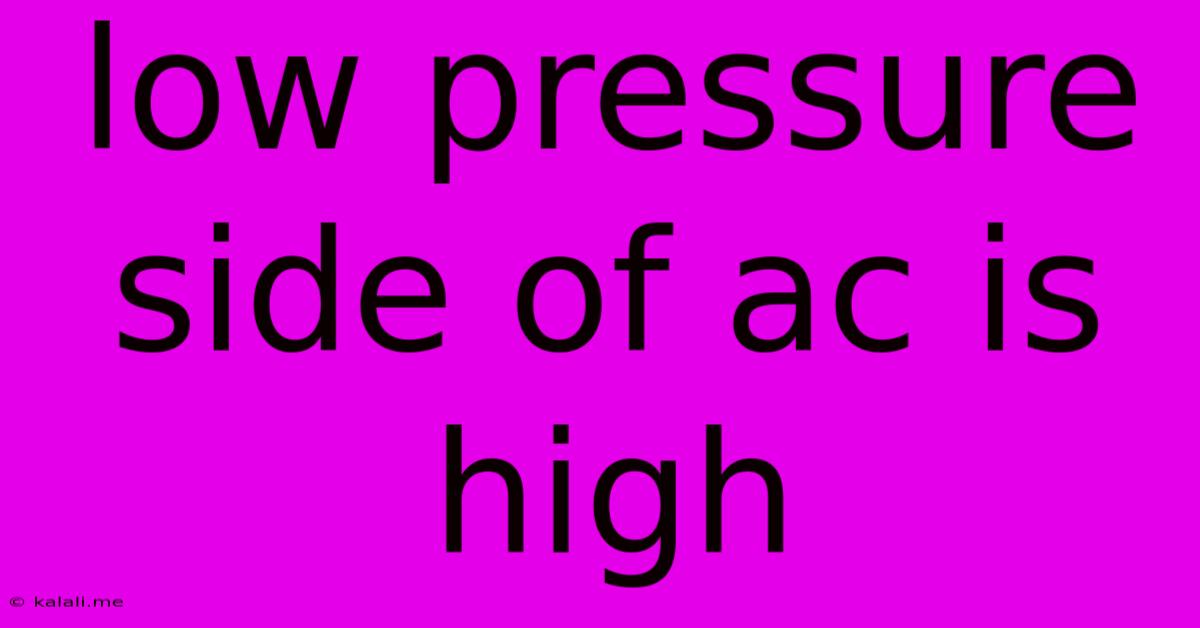Low Pressure Side Of Ac Is High
Kalali
May 23, 2025 · 4 min read

Table of Contents
Low Pressure Side of AC is High: Troubleshooting and Solutions
Meta Description: Experiencing high pressure on your AC's low side? This comprehensive guide explores the common causes, troubleshooting steps, and solutions for this air conditioning problem, helping you restore cool comfort quickly.
High pressure on the low-pressure side of your air conditioning system is a serious issue that can lead to significant problems and even damage your unit. It's not something to ignore. This counterintuitive situation signals a problem within the system, preventing it from cooling efficiently and potentially leading to costly repairs. This article will guide you through understanding why this happens, how to diagnose the problem, and what solutions you might consider.
Understanding Your AC System's Pressure
Before diving into troubleshooting, let's quickly review the basics. Your air conditioning system relies on a refrigerant cycle. The low-pressure side is where the refrigerant absorbs heat from your home, transitioning from a low-pressure, low-temperature gas to a low-pressure, higher-temperature liquid. The high-pressure side is where the refrigerant releases heat to the outside environment. A pressure imbalance, especially high pressure on the low side, indicates a malfunction.
Common Causes of High Low-Side AC Pressure
Several factors can contribute to high pressure on your AC's low-pressure side. Let's examine some of the most frequent culprits:
-
Restricted Refrigerant Flow: This is arguably the most common cause. A blockage somewhere in the system—in the evaporator coil, capillary tube, expansion valve, or even a clogged filter—prevents the refrigerant from flowing smoothly, resulting in a pressure buildup on the low side. Foreign objects, corrosion, or refrigerant freezing can all cause these restrictions. This is often accompanied by reduced cooling capacity.
-
Faulty Expansion Valve or Metering Device: The expansion valve (or metering device in some systems) controls the refrigerant flow. If this valve is malfunctioning, it can either restrict the flow completely or allow too much refrigerant into the evaporator, leading to high pressure. A sticky or damaged valve is a primary suspect.
-
Refrigerant Overcharge: While less common than restricted flow, overcharging the system with too much refrigerant can also increase low-side pressure. This extra refrigerant struggles to efficiently evaporate, creating a pressure imbalance.
-
Compressor Issues: While a faulty compressor typically manifests as low pressure across the system, in some cases, a failing compressor can cause unusual pressure readings including high pressure on the low side. This often indicates severe internal problems within the compressor.
-
Condenser Fan Problems: A malfunctioning condenser fan (located outside) reduces the ability of the condenser to reject heat effectively. This can lead to back pressure that affects the entire system including the low pressure side.
-
Dirty Evaporator Coil: A dirty evaporator coil (located inside) restricts airflow and hinders heat absorption, indirectly affecting the refrigerant flow and pressure.
Troubleshooting Steps
Diagnosing the exact cause requires careful observation and sometimes specialized tools. However, some preliminary checks can help narrow down the possibilities:
-
Check the Air Filter: A clogged air filter restricts airflow, directly impacting the system's efficiency and potentially leading to high low-side pressure. Replace it with a clean filter.
-
Inspect the Evaporator Coil: If accessible, visually inspect the evaporator coil for any obstructions or excessive dirt buildup. Cleaning the coil may resolve the issue.
-
Check the Condenser Fan: Ensure the condenser fan is operating correctly. A faulty fan motor or obstructed fan blades reduce cooling efficiency and can contribute to unusual pressure readings.
-
Monitor the System's Temperature: Pay attention to the temperature of the refrigerant lines. Unusual temperatures can indicate problems with refrigerant flow or the compressor.
Seeking Professional Help
While some minor issues like a clogged air filter can be addressed at home, determining the cause of high low-side pressure usually requires the expertise of a qualified HVAC technician. They possess the necessary tools and knowledge to accurately diagnose the problem and implement the appropriate repairs or replacements, preventing further damage to your air conditioning system. Improper handling of refrigerants can also be dangerous, highlighting the importance of professional intervention.
High pressure on the low side of your AC system is a serious issue that shouldn't be ignored. By understanding the potential causes and taking appropriate steps, you can restore your air conditioning system's performance and enjoy cool comfort once more. Remember to prioritize professional help for accurate diagnosis and safe repairs.
Latest Posts
Latest Posts
-
Access Custom Metadata Object In Profile
May 23, 2025
-
Can I Transport A Water Heater On Its Side
May 23, 2025
-
Can A Water Heater Be Transported On Its Side
May 23, 2025
-
Marlin Ho0w To Get Cr Touch To Probe In Grid
May 23, 2025
-
Can Thunderbolt 2 Go To Usb 3 0 Micro B
May 23, 2025
Related Post
Thank you for visiting our website which covers about Low Pressure Side Of Ac Is High . We hope the information provided has been useful to you. Feel free to contact us if you have any questions or need further assistance. See you next time and don't miss to bookmark.